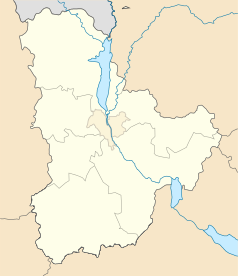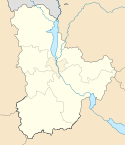Muzeum czarnobylskie
 | |
| Państwo | |
|---|---|
| Miejscowość | |
| Adres | Hjrevij 1 |
| Data założenia | 25 kwietnia 1992 |
Położenie na mapie Ukrainy (c) Karte: NordNordWest, Lizenz: Creative Commons by-sa-3.0 de | |
Muzeum czarnobylskie (ukr. Нацiональный музей "Чорнобиль", Muzeum Narodowe „Czarnobyl”) – muzeum utworzone w Kijowie dla upamiętnienia katastrofy w Czarnobylskiej Elektrowni Jądrowej w 1986 roku.
Historia
Muzeum powstało jako pomnik ofiar awarii reaktora elektrowni jądrowej w Czarnobylu. Przez jednych nazywane muzeum pamięci, przez innych muzeum narodowej tragedii. Zostało otwarte w przeddzień szóstej rocznicy katastrofy, 25 kwietnia 1992 roku, w specjalnie na ten cel przystosowanym budynku straży pożarnej. 25 kwietnia 1998 roku, w dwunastą rocznicę awarii elektrowni atomowej, ukraiński prezydent Łeonid Kuczma podniósł muzeum czarnobylskie do rangi narodowego.
Ekspozycję tworzą tysiące zdjęć przedstawiających wysiedlonych mieszkańców Prypeci i okolicznych wiosek. Uzupełniają ją krótkie filmy pokazujące miasto w 1986 roku oraz później jako wymarłego miasta. Przed muzeum są zaparkowane dwa UAZy 469B i RAF 2203158, które brały udział w akcji ratunkowej po awarii elektrowni. Symbolem muzeum jest obumarła w połowie jabłoń – drzewo poznania dobra i zła. Jest to alegoria siły energii jądrowej, która pod kontrolą człowieka przynosi dobre owoce, ale może nieść śmierć i zniszczenie.
Linki zewnętrzne
Media użyte na tej stronie
(c) Karte: NordNordWest, Lizenz: Creative Commons by-sa-3.0 de
Location map of Ukraine
Autor:
Autor: RosssW, Licencja: CC BY-SA 4.0
Districts of the Kiev region, from July 17, 2020
Autor: Jorge Láscar from Australia, Licencja: CC BY 2.0
The Ukrainian National Chornobyl Museum is a history museum in Kiev, Ukraine, dedicated to the 1986 Chernobyl disaster and its consequences. It houses an extensive collection of visual media, artifacts, scale models and other representational items designed to educate the public about many aspects of the disaster. Several exhibits depict the technical progression of the accident, and there are also many areas dedicated to the loss of life and cultural ramifications of the disaster.
Due to the nature of the subject material, the museum provides a very visually engaging experience. Symbolic display of "road signs" for the villages abandoned as a result of the disaster. To stress the tragedy of devastation, the signs are colored in black (instead of standard blue/white) and slashed with pink stripe (which designates "end of the settlement" on the actual signs). Above the signs is an authentic Khorugv from the abandoned village church.
Museum occupies an early 20th century building which formerly housed a fire brigade and was donated in 1992 by the State Fire Protection Guard. [Wikipedia.org]






